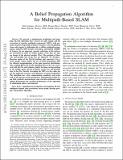A Belief Propagation Algorithm for Multipath-Based SLAM
Author(s)
Leitinger, Erik; Meyer, Florian; Hlawatsch, Franz; Witrisal, Klaus; Tufvesson, Fredrik; Win, Moe Z; ... Show more Show less
DownloadAccepted version (7.598Mb)
Open Access Policy
Open Access Policy
Creative Commons Attribution-Noncommercial-Share Alike
Terms of use
Metadata
Show full item recordAbstract
© 2002-2012 IEEE. We present a simultaneous localization and mapping (SLAM) algorithm that is based on radio signals and the association of specular multipath components (MPCs) with geometric features. Especially in indoor scenarios, robust localization from radio signals is challenging due to diffuse multipath propagation, unknown MPC-feature association, and limited visibility of features. In our approach, specular reflections at flat surfaces are described in terms of virtual anchors (VAs) that are mirror images of the physical anchors (PAs). The positions of these VAs and possibly also of the PAs are unknown. We develop a Bayesian model of the SLAM problem and represent it by a factor graph, which enables the use of belief propagation (BP) for efficient marginalization of the joint posterior distribution. The resulting BP-based SLAM algorithm detects the VAs associated with the PAs and estimates jointly the time-varying position of the mobile agent and the positions of the VAs and possibly also of the PAs, thereby leveraging the MPCs in the radio signal for improved accuracy and robustness of agent localization. The algorithm has a low computational complexity and scales well in all relevant system parameters. Experimental results using both synthetic measurements and real ultra-wideband radio signals demonstrate the excellent performance of the algorithm in challenging indoor environments.
Date issued
2019Department
Massachusetts Institute of Technology. Laboratory for Information and Decision SystemsJournal
IEEE Transactions on Wireless Communications
Publisher
Institute of Electrical and Electronics Engineers (IEEE)